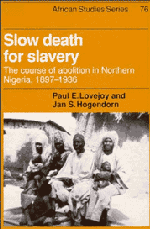Book contents
- Frontmatter
- Contents
- List of maps
- List of tables
- Preface
- 1 Slavery and the British conquest of Northern Nigeria
- 2 Fugitive slaves and the crisis in slavery policy
- 3 The debate on legal-status abolition
- 4 Emancipation and the law
- 5 Upholding proprietary rights to land
- 6 The role of taxation in the reform of slavery
- 7 The colonial economy and the slaves
- 8 The persistence of concubinage
- 9 Legal-status abolition: the final phase
- Appendix: Court records of slaves issued certificates of freedom
- Notes
- Glossary
- Bibliography
- Index
- Title in the series
Preface
Published online by Cambridge University Press: 03 May 2011
- Frontmatter
- Contents
- List of maps
- List of tables
- Preface
- 1 Slavery and the British conquest of Northern Nigeria
- 2 Fugitive slaves and the crisis in slavery policy
- 3 The debate on legal-status abolition
- 4 Emancipation and the law
- 5 Upholding proprietary rights to land
- 6 The role of taxation in the reform of slavery
- 7 The colonial economy and the slaves
- 8 The persistence of concubinage
- 9 Legal-status abolition: the final phase
- Appendix: Court records of slaves issued certificates of freedom
- Notes
- Glossary
- Bibliography
- Index
- Title in the series
Summary
Writing a volume on Northern Nigeria's slave system, one of the largest slave societies in modern history, poses more than ordinary difficulty, because no books on the subject have come before. Prior to this study, only about twenty articles have been published on our topic. Thus this first book-length study of slavery in the region of Northern Nigeria bears little similarity to the work on American slavery of Ulrich Phillips, Kenneth Stamp, Stanley Elkins, Eugene Genovese, or Stanley Engerman. These scholars could draw on an already existing wealth of information, whereas we could not.
Our direct interest in the slave system of the Sokoto Caliphate, and the painfully slow end of that system extending over many years of British colonial rule, dates from the year 1975. In that year, we were visiting academics at Ahmadu Bello University in Zaria. Jan Hogendorn had just published an article on the economics of the Atlantic slave trade that included a section on slave supply conditions within West Africa. He commented that he wished he had some of this knowledge when writing his Ph.D. thesis on Northern Nigerian groundnut production, since slaves surely played a part in the development of this crop. Paul Lovejoy noted that slaves had figured in his own Ph.D. thesis on the kola trade between the Sokoto Caliphate and Asante. Many wealthy kola merchants of slave origin had subsequently invested heavily in slave-based agriculture.
- Type
- Chapter
- Information
- Slow Death for SlaveryThe Course of Abolition in Northern Nigeria 1897–1936, pp. xi - xviPublisher: Cambridge University PressPrint publication year: 1993

